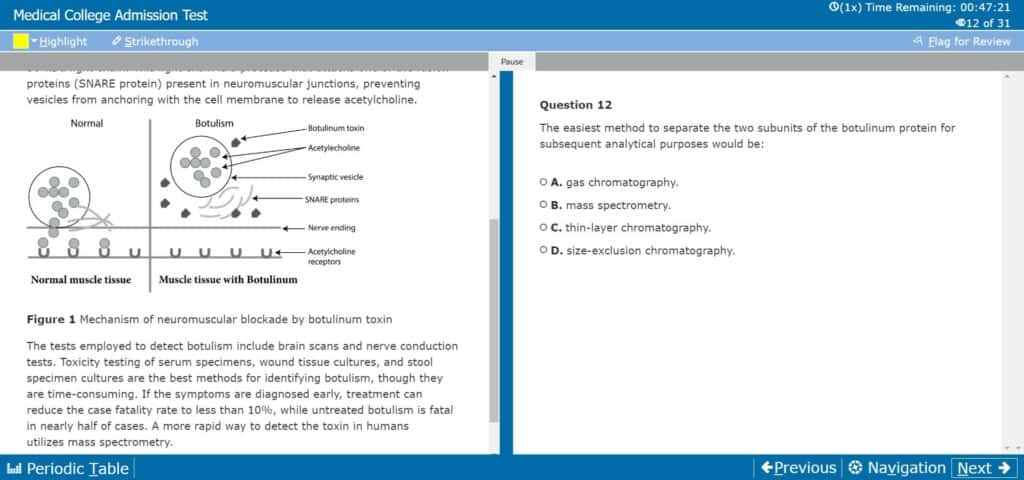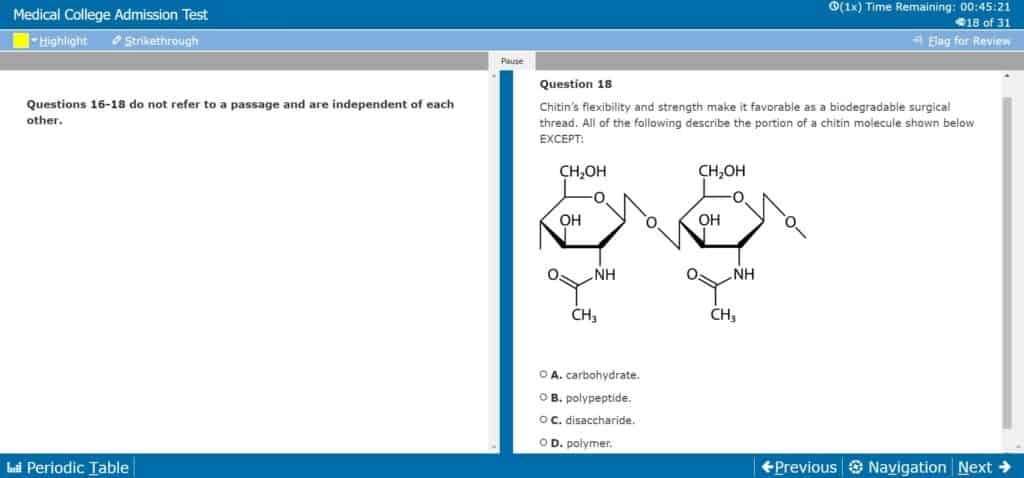Blueprint’s MCAT courses are highly acclaimed by pre-med students.
What you may not know, however, is that their free practice account includes access to plenty of free study resources, including a free MCAT diagnostic test.
An MCAT diagnostic test is a significant stage in your MCAT journey seeing as this one test will set the tone for your entire MCAT prep and study schedule.
So naturally, you would want to make sure that you are using the best diagnostic test and not one that will prove to be a mere waste of time.
Is the Blueprint diagnostic MCAT test worth it? Just how much value could you possibly derive from this 20-passage-long half-length test?
Well, let’s find out.
Quick Summary
- Blueprint diagnostic MCAT is a half-length test containing 20 passages and taking about 3.5 hours to complete.
- This test is completely free and anyone can access it with a free Blueprint MCAT account. However, make sure to sign up with a discount code for Blueprint so that when you decide to purchase the course, you will be sure to get the best deal.
- Owing to its AAMC representativeness and high statistical validity, Blueprint’s diagnostic test is incredibly accurate in setting your performance baseline.
- The best time to take the Blueprint MCAT diagnostic test is right at the beginning of your MCAT prep, even before you begin studying.
- On average, anything above 500 counts as a good Blueprint diagnostic score.
What Is An MCAT Diagnostic Test?
An MCAT diagnostic test is a multiple-choice exam designed to mimic the structure, content, and length of the actual MCAT exam.
Now, this description may sound just like any other MCAT practice test, so I’m sure you may be wondering what’s the difference between an MCAT diagnostic and an MCAT practice test.
Well, unlike MCAT practice tests, diagnostic exams are not study tools.
Instead, the purpose of a diagnostic is to diagnose where you are in your MCAT prep journey, and the purpose of a practice test is to get you ready for test day.
A diagnostic test is meant to have you experience the MCAT in its full breadth and complexity, thereby providing an accurate measure of your current knowledge in typically all sections of the MCAT.
An MCAT diagnostic shows you the different types of MCAT questions, giving you an idea of the test, what’s tested, how content is tested, and how hard the MCAT is.
The main focus of a diagnostic test is neither your performance nor your score. Instead, diagnostics are supposed to give you an accurate baseline on which to base your MCAT study schedule.
By revealing your strengths and weaknesses, MCAT diagnostics provide a clear understanding of exactly where you stand as far as your content grasp goes.
You may have performed quite well in your medical school prerequisites coursework, but then upon taking a diagnostic exam, you may find that you do not recall as much Biochemistry as you thought.
Or maybe you have a firmer knowledge of Physics than you’d have guessed.
This is exactly what a diagnostic test is all about. You get a comprehensive understanding of which content areas you need to focus on in your MCAT prep.
MCAT diagnostic tests come in two main formats: a full-length diagnostic that takes 7.5 hours or a half-length diagnostic that takes 3.5 hours.
Either option is perfectly fine as long as the diagnostic test meets the following criteria:
- Mimics the structure and length of the actual MCAT.
- Covers each of the MCAT’s sections.
- Simulates the difficulty of the real exam.
- Gives you an approximate score at the end.
Taking The Blueprint Diagnostic MCAT Test
The Blueprint diagnostic MCAT test is a half-length test containing 20 passages and taking about three and a half hours to complete.
This is actually a free MCAT diagnostic exam meaning you do not have to sign up for a Blueprint MCAT course to access it. You can do so simply with a free account.
Many people are skeptical about how efficient or beneficial half-length diagnostics are, but I assure you they are just as good, if not better, than full-length diagnostics.
Why Take The Blueprint Diagnostic MCAT Exam?

First, starting off with a half diagnostic is an excellent idea because the test won’t take up too much precious study time. While a full-length practice exam is 7.5 hours long, you get to complete a half diagnostic in just 3.5 hours.
Secondly, Blueprint’s MCAT diagnostic test is perfectly designed with high statistical validity. Its format and rigor closely resemble that of the real MCAT, and the test contains practice passages from each of the four MCAT sections.
Thirdly, although this is just a half-length exam, Blueprint has tweaked its scoring scale such that your diagnostic score represents a real MCAT score.
All in all, Blueprint’s half-length diagnostic MCAT exam does a great job of presenting you with an accurate picture of where you stand and how much effort lies between you and your goal score.
You get to see where your content gaps lie in a much shorter time and also without being discouraged about the scores and draining nature of a full-length diagnostic.
The MCAT is an intimidating exam, not just in content tested, but also in its length and format.
Considering that this is unlike any other exam you’ve ever sat for before this point, starting off with a full-length diagnostic will appear that much more intimidating, and so you might end up pushing it off further than necessary, as opposed to if you had to face a half-length diagnostic.
And you really wouldn’t want to push off taking your diagnostic MCAT test. It may appear unnecessary, but diagnostics are an incredibly important part of your MCAT prep.
Without a way to accurately measure your current knowledge, how else would you know what you need to review and improve on?
The MCAT tests an incredibly vast pool of knowledge, and deciding to go about your studying blindly using pure guesswork is really not a winning strategy.
As such, the Blueprint diagnostic gives you an accurate estimate of your baseline performance, which is a great starting point for your MCAT prep, from which you can now best strategize and plan your study time accordingly.
When Should I Take The Blueprint Diagnostic MCAT Test?
The best time to take the Blueprint diagnostic MCAT test is right at the beginning of your MCAT prep. By which I mean the minute you’re contemplating taking the MCAT, your first move, before all else, should be to take a diagnostic test.
The entire point of a diagnostic test is to gauge your level of content knowledge, thereby informing how much preparation you will need before facing the actual exam.
It’s typical human nature to want to perform well in any test. So many students will put off taking a diagnostic, giving themselves time to do a bit of content review before taking the test, but this is the wrong approach.
Diagnostic exams aren’t about scores or how well you will perform on the test.
Instead, diagnostics are supposed to provide a starting point for your MCAT journey. As a matter of fact, the day you take your MCAT diagnostic test should be considered the first day of your MCAT prep.
So you should only take this exam when you are entirely sure that you are ready to start prepping for the MCAT.
Just because you have taken all the prerequisites doesn’t mean that you are ready to face the MCAT, and a diagnostic test will reveal just that.
This test is meant to plainly reveal your strong and weak areas, as well as provide an accurately estimated MCAT score, so you can know how much time and effort you need to put into your MCAT prep and so that you can plan your MCAT test date accordingly.
It is not about scoring highly. It is about testing yourself and seeing the extent of your content knowledge. It is about seeing your baseline performance, so you can best plan how to proceed from there.
So as long as you have completed the required prerequisite coursework and are now contemplating taking the MCAT, your first move should be to take the Blueprint diagnostic test to measure your knowledge.
Just make sure you take the test appropriately timed, as directed by Blueprint. Also, as much as possible, ensure your test-taking environment mimics the actual MCAT test day conditions.
How Hard Is The Blueprint Diagnostic MCAT Test?
Blueprint MCAT tests, in general, tend to be slightly harder than AAMC tests and, consequently, harder than the actual MCAT as well. This applies to the Blueprint diagnostic MCAT test as well.

But even though they are slightly more challenging than the real deal, Blueprint tests are still highly representative of the real MCAT in terms of the test structure, how questions are asked, and the type of content that’s tested.
As far as difficulty goes, you can reasonably assume that Blueprint test scores are deflated by 3-7 points or so.
Meaning if you scored a 503 on your Blueprint MCAT diagnostic test, you could expect to score maybe a 508 or so on the real exam.
Of course, this is not a hard and fast rule or a magical kind of score conversion. Ultimately, your final MCAT performance on the real test will depend on your own effort and dedication to your studies and to your MCAT prep in general.
There have been cases of students going from a diagnostic score of 490 to an MCAT score of 515 in a relatively short amount of time.
Don’t be discouraged by a poor Blueprint MCAT Diagnostic score, and just as well, getting a great score on your Blueprint diagnostic test shouldn’t make you complacent.
Don’t sit back thinking you’ll do just fine on the real test after such a stellar performance on a more difficult exam. You still need to put in the hard prep work.
What’s A Good Blueprint Diagnostic MCAT Score?
Before we get into actual figures, you need to keep in mind that the point of a diagnostic test isn’t the scores you get but rather, what’s important here is the critical analysis of your performance on the test.
This means that aside from the overall test score, you should also pay attention to your sectional scores and their respective percentile ranks.
That being said, anything above 500 is actually a pretty decent Blueprint diagnostic MCAT score, as this would typically fall above the 50th percentile.
That’s a great starting point considering you haven’t put in any studying prior to taking the diagnostic.
A score of 508 or above would typically fall beyond the 70th percentile, and this would be considered a great Blueprint MCAT diagnostic score.
If you haven’t scored under 125 in any sections, well done! That’s actually an impressive point to start from and it shows that you at least know your MCAT content fairly well.
You may be tempted to disregard a good Blueprint MCAT diagnostic test score because, after all, this is just a half-length test and might not be as accurately indicative of your real MCAT scores as full-length practice tests.
Well, don’t.
Even though this free MCAT practice test is a half-length diagnostic, there typically aren’t huge score drops from half-length tests to full-length tests. So don’t even worry about that.
Besides, the Blueprint diagnostic really is a well-designed test that’s incredibly representative of the actual MCAT and paints a very accurate picture of where you stand as you begin your MCAT prep.
Blueprint Diagnostic MCAT Vs. AAMC Test Difficulty
Blueprint MCAT, formerly Next Step test prep, has always had very accurate scaling whereby their diagnostic test scores are highly predictive of actual AAMC scores.
Nevertheless, Blueprint is actually slightly harder than an AAMC test, so your scores will be deflated to a slight degree, or at least that’s the case with a vast majority of students.
You can safely expect your score to jump by about 7 or so points from your Blueprint diagnostic to your first AAMC full-length test.
Chem/Phys is notorious for being Blueprint’s most deflated section. Take a little solace in this, but still put in the hard work.
One significant difference you might notice between Blueprint diagnostic test and an AAMC test is that while AAMC tests content in a more connected and holistic manner, Blueprint is more discrete and focused on details.
Nevertheless, overall, Blueprint is still very representative of AAMC tests.
Blueprint Diagnostic MCAT FAQs
Which Is The Best MCAT Diagnostic Test To Take?
The best Blueprint MCAT test should meet the following criteria:
a) Mimics the structure and format of the actual MCAT.
b) simulates the rigor and difficulty of the real exam.
c) Contains practice passages from each of the four MCAT sections.
d) Has timed sections as per AAMC regulations.
e) Provides an approximate MCAT score at the end.
That being said, the best thing would be to start off with a free diagnostic test such as the one provided by Blueprint.
This will give you a clear picture of what you need to work on and to what extent, so you can best weigh your test prep options.
Besides the free Blueprint diagnostic, I would also highly recommend AAMC’s MCAT practice exam one. This is an official MCAT diagnostic test and costs $35.
Is The Blueprint Diagnostic MCAT Test Worth It?
Yes, the Blueprint diagnostic MCAT test is absolutely worth it.
Free things often attract a healthy amount of skepticism regarding their quality and beneficence, but let me assure you that the Blueprint diagnostic is a top-tier exam.
Although it is a half-length test containing just 20 passages, it still does a great job of giving you an accurate idea of what’s on the MCAT and how hard it is.
The test has high statistical validity, meaning you can efficiently use it to gauge exactly where you stand as far as your MCAT content grasp is concerned.
Although slightly deflated, the Blueprint diagnostic test can conveniently be used to accurately predict your performance on the real MCAT.
What Is The Average Blueprint Diagnostic MCAT Score?
The average Blueprint diagnostic MCAT score tends to range between 502 and 508 for most students.
Generally, anything above 500 is a decent benchmark by far, especially for Blueprint, which is notorious for being more challenging than the AAMC tests.
Also, although Blueprint is generally deflated by around 7 or so points, nobody is to say that you cannot see a score increase of even 20 points on your real test.
Diagnostic scores are just a starting point. How you proceed from there is entirely up to you, based on your study discipline and dedication.
There are students that scored a 490 on their Blueprint diagnostic and went on to get a 510 on the actual exam. It is very much doable.
Is The Blueprint Diagnostic MCAT Test Full-Length?
No, the Blueprint diagnostic MCAT is a half-length test, not a full-length.
Nevertheless, the test is still highly representative of the AAMC and gives great score predictivity as well as accurately revealing your strong and weak areas.
Furthermore, a shorter test means less intimidation and discouragement and also less wastage of precious study time very early into your MCAT preparation.





